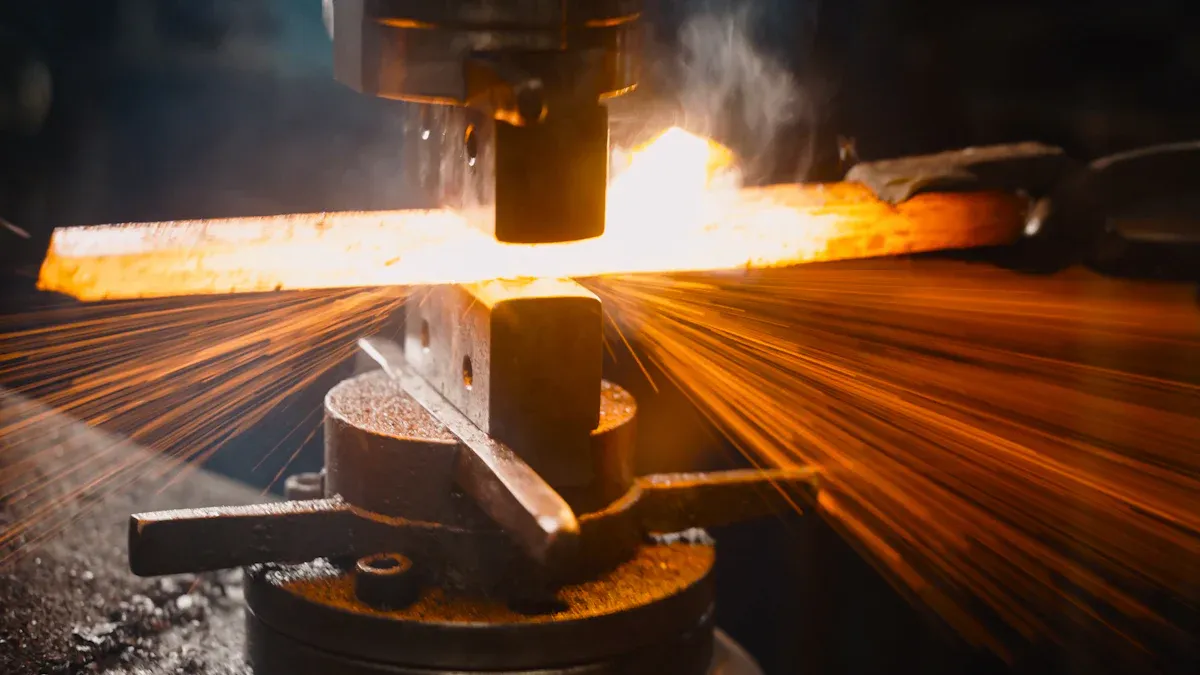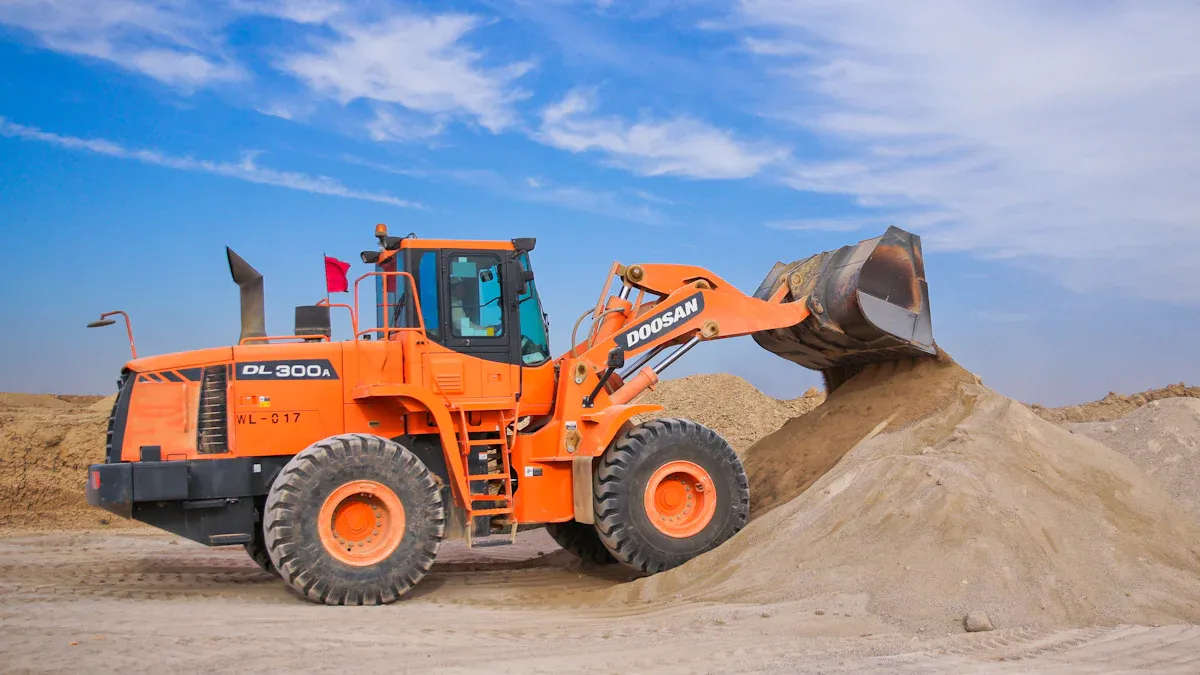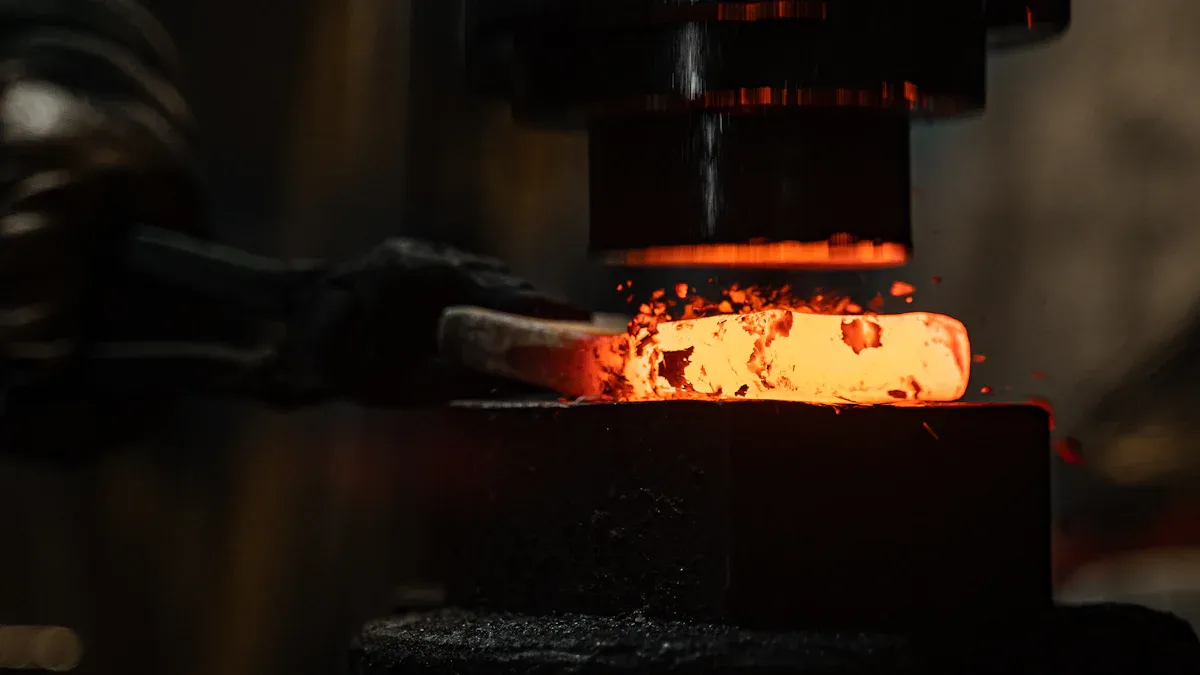
Precision free forging services play a vital role in manufacturing heavy machinery components. This process involves shaping metal under high pressure to enhance its structural integrity. Industries prefer forged components due to their unmatched strength and durability, which are critical for safety and performance. Additionally, customization options allow manufacturers to meet specific design requirements.
- Forged parts excel in applications requiring fatigue resistance and fracture toughness.
- The global adoption of forging for essential components, such as turbine shafts and structural parts, highlights its reliability.
- The process reduces material waste while improving grain flow, ensuring superior strength.
Key Takeaways
- Precision free forging makes heavy machine parts stronger and tougher. These parts work well in jobs with high pressure or stress.
- This method uses less material and costs less to make. It saves more money compared to older machining ways.
- Free forging lets makers design parts to fit exact needs. This helps the parts work their best.
Understanding Free Forging Services
What Is Precision Free Forging?
Precision free forging is a manufacturing process that shapes metal by applying high pressure without the use of pre-shaped dies. This method involves heating the metal to a specific temperature, typically around 900°C, to enhance its malleability. The process ensures superior structural integrity by aligning the grain flow of the material, resulting in components with exceptional strength and durability. Industries rely on this technique to produce parts that meet exacting specifications, minimizing the need for extensive post-forging machining.
The global adoption of free forging services reflects its importance in modern manufacturing. The market for free forging hydraulic presses, valued at approximately USD 2.5 billion in 2023, is projected to grow at a CAGR of 5.4%, reaching USD 4.1 billion by 2032. This growth is driven by increasing demand in sectors like heavy machinery and automotive, where high-strength components are essential.
How It Differs from Other Forging Methods
Precision free forging stands apart from other forging methods due to its adaptability and efficiency. Unlike closed-die forging, which uses pre-shaped molds, free forging allows for greater flexibility in producing custom shapes. This method also reduces material waste, as it requires less input weight while achieving superior strength through plastic deformation. Additionally, free forging produces components with enhanced structural integrity, making it ideal for heavy machinery applications.
Comparative studies highlight the advantages of precision free forging over traditional methods. The process achieves net shape or near-net shape parts, reducing the need for additional machining. It also supports both cold and hot forming techniques, making it versatile for various alloys and applications.
Key Features of Precision Free Forging
Precision free forging offers several key features that make it indispensable for heavy machinery manufacturing:
- Dimensional Accuracy: Controlled forging processes ensure components meet exact specifications.
- Structural Integrity: The method enhances strength and durability through grain flow alignment.
- Material Efficiency: Reduced waste and minimal machining lower production costs.
- Temperature Control: Consistent heating prevents thermal shock and ensures quality.
- Adaptability: Suitable for both cold and hot forming, accommodating diverse materials.
This process emphasizes efficiency and quality, producing components that meet the rigorous demands of industries like aerospace, automotive, and shipbuilding.
Benefits for Heavy Machinery Components
Superior Strength and Durability
Precision free forging ensures exceptional strength and durability in heavy machinery components. The process aligns the grain flow of the material, enhancing its structural integrity. Advanced non-destructive testing (NDT) techniques, such as ultrasonic and magnetic particle inspections, verify the quality of forged parts. These methods achieve detection rates of up to 99.8% for internal flaws and 98% for surface defects. Mechanical property testing further confirms the superior strength, hardness, and ductility of forged components with 99.7% accuracy.
Open die forged shafts demonstrate a lifespan of 25-30 years, significantly outlasting cast alternatives, which typically last 15-20 years. Failure rates in high-stress environments are 70% lower for forged components, making them ideal for demanding applications. Heavy machinery equipped with forged parts also experiences a 40-50% reduction in maintenance frequency, ensuring long-term reliability.
Cost-Effectiveness and Efficiency
Free forging services offer substantial cost savings and operational efficiency. The process minimizes material waste by up to 30% compared to traditional machining methods. Open die forging increases overall cost-effectiveness by 15-20%, particularly for large shaft production. Heavy machinery utilizing forged components benefits from reduced maintenance costs and extended service life.
| Evidence Description | Value |
|---|---|
| Increase in overall cost-effectiveness | 15-20% |
| Reduction in maintenance frequency | 40-50% |
| Average lifespan of open die forged turbine shafts | 25-30 years |
| Average lifespan of cast alternatives | 15-20 years |
Customization for Specific Needs
Free forging services provide unmatched flexibility in meeting specific design requirements. The process accommodates a wide range of materials and shapes, enabling manufacturers to produce components tailored to unique applications. This adaptability ensures that heavy machinery components meet exacting industry standards while maintaining high performance. Customization also reduces the need for extensive post-forging machining, saving time and resources.
Applications in Heavy Machinery

Common Components (e.g., Shafts, Gears)
Heavy machinery relies on components like shafts and gears to perform under extreme conditions. Free forging services produce these parts with superior strength and durability, ensuring they withstand high stress and fatigue. Shafts forged through open die methods exhibit a lifespan of up to 25 years, outperforming cast alternatives that last only 15 years. Gears forged using precision techniques maintain dimensional accuracy, reducing wear and tear over time.
A cost comparison highlights the long-term benefits of forged components. Open die forging incurs higher initial production costs but offers lower maintenance and downtime expenses. Over 25 years, forged shafts and gears save up to $200,000 compared to cast alternatives. This cost efficiency makes free forging services indispensable for industries requiring reliable and long-lasting machinery parts.
| Cost Factor | Open Die Forging | Alternative Method (e.g., Casting) |
|---|---|---|
| Initial Production Cost | $100,000 | $75,000 |
| Average Lifespan | 25 years | 15 years |
| Maintenance Cost (per year) | $2,000 | $5,000 |
| Downtime Cost (per year) | $10,000 | $25,000 |
| Total Cost Over 25 Years | $400,000 | $600,000 |
Industries That Rely on Free Forging Services
Several industries depend on free forging services to meet their manufacturing needs:
- Automotive: High-strength components for engines and transmissions.
- Aerospace: Precision parts for turbines and landing gear.
- Railway: Durable axles and wheels for locomotives.
- Heavy Equipment: Large shafts and gears for construction machinery.
- Wind Power: Forged hubs and shafts for wind turbines.
These sectors prioritize forged components for their reliability and ability to meet stringent performance standards.
Real-World Examples of Applications
Free forging services play a critical role in producing components for heavy machinery used in construction, mining, and manufacturing. In construction, forged shafts power cranes and excavators, ensuring operational efficiency. Mining equipment, such as drills and loaders, relies on forged gears to handle abrasive conditions. Manufacturing industries use forged turbine shafts to maintain precision in high-speed operations.
The demand for forged components continues to grow due to trends like infrastructure development and the expansion of mining activities. Industries increasingly adopt free forging services to produce parts that combine strength, durability, and cost-effectiveness.
The Precision Free Forging Process

Step-by-Step Overview
The precision free forging process involves several critical steps to ensure high-quality components. First, the raw material undergoes heating to a specific temperature, typically between 900°C and 1,200°C, to improve its malleability. Next, skilled technicians shape the heated material using hydraulic presses or hammers, applying controlled force to achieve the desired form. During this stage, the grain structure aligns, enhancing the component’s strength and durability. After shaping, the forged part undergoes cooling under controlled conditions to prevent thermal stress. Finally, post-forging processes, such as heat treatment and machining, refine the component to meet precise specifications.
Materials Used in Free Forging
Free forging services utilize a wide range of materials to meet diverse industrial needs. Commonly used metals include carbon steel, alloy steel, stainless steel, and non-ferrous alloys like aluminum and titanium. Each material offers unique properties, such as corrosion resistance, high tensile strength, or lightweight characteristics, making them suitable for specific applications. For instance, stainless steel is ideal for components exposed to harsh environments, while titanium is preferred for aerospace applications due to its strength-to-weight ratio. The selection of material depends on the component’s intended use and performance requirements.
Quality Control and Assurance
Quality control is a cornerstone of the precision free forging process. Advanced inspection techniques, such as ultrasonic testing and magnetic particle inspection, detect internal and surface defects with high accuracy. Dimensional checks ensure that components meet exact specifications, while mechanical property testing verifies strength, hardness, and ductility. Adherence to international standards, such as ISO 9001, guarantees consistent quality. By implementing rigorous quality assurance measures, manufacturers deliver reliable and durable components that meet the demands of heavy machinery industries.
Choosing a Service Provider
Evaluating Expertise and Experience
Selecting the right provider for free forging services requires careful evaluation of their expertise and experience. Companies with decades of industry presence often demonstrate a proven track record of delivering high-quality components. Providers with skilled engineers and technicians ensure precision in every stage of the forging process. Reviewing case studies or client testimonials can offer insights into their ability to meet specific project requirements. Additionally, providers with experience in diverse industries, such as automotive, aerospace, and heavy equipment, bring valuable knowledge to complex projects.
Importance of Certifications and Standards
Certifications and adherence to international standards reflect a provider’s commitment to quality. ISO 9001 certification, for instance, ensures that the company follows stringent quality management practices. Providers that comply with industry-specific standards, such as AS9100 for aerospace or IATF 16949 for automotive, demonstrate their ability to meet specialized requirements. Certifications also indicate that the provider invests in continuous improvement, ensuring consistent quality and reliability in their forging processes.
Assessing Technology and Capabilities
Advanced technology and robust capabilities are essential for delivering precision-forged components. Providers equipped with modern forging presses, CNC machines, and heat treatment facilities can handle complex designs and large-scale production. The ability to forge components up to 80 tons, for example, highlights their capacity to meet demanding industrial needs. Additionally, providers that utilize non-destructive testing methods and advanced inspection tools ensure the highest levels of quality assurance. Evaluating these factors helps identify a partner capable of meeting both current and future requirements.
Precision free forging remains essential for manufacturing heavy machinery components. Its unmatched strength, durability, and customization capabilities ensure superior performance across industries. Selecting a provider with proven expertise and advanced technology guarantees reliable results. Companies like Rongli Forging Co., Ltd. exemplify excellence, offering ISO-certified processes and decades of experience to meet diverse industrial needs.
FAQ
What industries benefit the most from precision free forging services?
Industries like aerospace, automotive, heavy equipment, and wind power benefit significantly. These sectors require high-strength, durable components for critical applications.
How does precision free forging improve component quality?
The process aligns the material’s grain flow, enhancing strength and durability. Advanced quality control methods ensure components meet exact specifications and industry standards.
Why choose Rongli Forging Co., Ltd. for free forging services?
Rongli offers over 20 years of expertise, ISO-certified processes, and advanced equipment. Their team ensures precision, reliability, and fast lead times for diverse industrial needs.
Post time: Mar-26-2025



